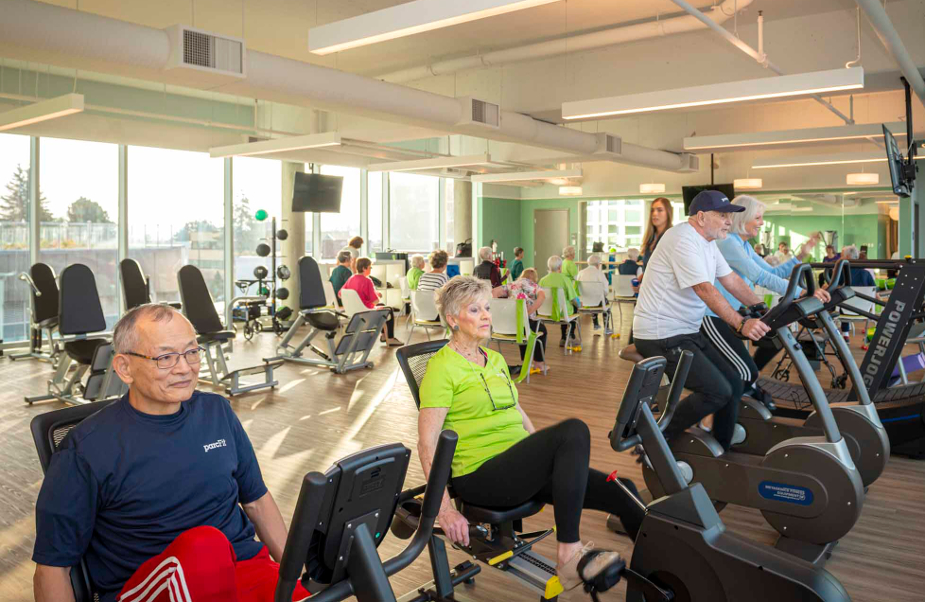The changing face of retirement living in small-town B.C. means you can start planning now, by settling into a smaller centre that meets your later-life needs–for about a third less than the big-city cost.
By Michelle Hopkins
Every day, 78-old, Sylvia Lindaas laces up her runners and heads out for a brisk walk–not just once, but twice a day. When the gregarious grandmother was looking for a seniors’ residence, she wanted a modern, young and lively place to call home, in a community offering lots of outdoor activities. Four years ago, the spry senior left the big city behind to move to Kamloops.
“I certainly don’t feel as if I’m in a senior’s home,” Lindaas says, with a laugh in her voice, describing the Residence at Orchards Walk. “This building us uplifting, it’s fun, and I’m having a good time enjoying everything–especially my place.”
She chose to move to a smaller B.C. city because, “It’s much better priced than the Lower Mainland and it’s a much newer residence.” Her contemporary, open-concept 670-square-foot apartment features a patio where she can safely entertain family and friends, overlooking lush gardens. A theatre, gym, salon, spa and restaurant are other perks of the residence.
For lifestyle and financial reasons, moving to B.C.’s smaller towns is a growing trend amongst seniors. According to the 2019 CMHC Seniors’ Housing Report, the average rent in rural areas, such as the Kootenays or Vancouver Island, can be as much as 35 per cent less than in Greater Vancouver. That translates to an average of $3,632 a month for a one-bedroom package in the Lower Mainland, versus $2,670 a month on average for Vancouver Island or the Central Coast.
LUXE FOR LESS
Lina Saba, director of sales and marketing for Park Place Seniors Living, which operates the Residence at Orchards Walk plus over 30 others across B.C. and Alberta (including assisted living and care facilities), says Lindaas’ comments are echoed by many residents. “The appeal of small-town residences is its great lifestyle without the expensive price tag of the Lower Mainland.”
Saba describes the Park Place lifestyle as one with “five-star resort-style amenities and services” that allows the 55-plus set to live rich and independent lives. For example, she says, “We host happy hours with a wine bar, talent nights similar to cruise ships, and in the restaurant, we offer à la carte dining with lots of options.”
Landon Elliott, chief marketing officer for Golden Life Management Corporation, which owns and operates 16 seniors’ residences across the province (including in Cranbrook, Trail and Invermere), says today’s lively seniors’ residences defy all the sedate, blue-haired clichés. “We offer bike rides, lake trips, fundraising dances and food shows every six months, where we bring together residents from different villages to experience the cuisine from various chefs,” adds Elliott.
At both Golden Life and Park Place Seniors Living residences, most rental suites come with an array of services, starting with menu-chosen or tailored meals by Red Seal trained chefs, as well as weekly cleaning services, activities, arts and culture programs, fitness centres, small theatres, computer rooms and much more.
CALL OF THE WILD
There’s a reason that B.C.’s small-town senior living communities are thriving. “Our seniors are active and looking to maintain a happy, healthy yet ‘lock-in-key’ lifestyle,” says Golden Life’s Elliott. “We call our residences senior lifestyle villages, as we see them as community hubs for entertainment and social gatherings, while providing access to the great outdoors.”
Many of today’s baby boomers are searching for a place where they can make connections, away from the hustle and bustle of city living; for many, smaller towns fit the bill better than bigger, anonymous cities.
PARC Retirement Living, which owns and operates five independent living residences across the province and has three more residences in development–in Coquitlam, Victoria and Kelowna–notes the same trend. “When many baby boomers are ready to retire, there is little chance that a sedate retirement community would make a suitable destination for them,” says Margaret Lucas, executive director of business development for PARC Retirement Living. “Our homes are a place you go to thrive and enjoy healthy lifestyles.”
PARC residences not only offer restaurant-style dining with Red Seal chefs as well, they create unique opportunities to engage with others. “In Victoria, we will offer multi-generational interaction,” says Lucas. “We will have a licensed daycare on site and a music wellness centre.”
STAYING ENGAGED
In the end, one of the major reasons people chose to move to a shared housing community is social engagement. For Lindaas, the location, amenities and community all add up to the lifestyle of her choice. Her new home is modern, bright and a comfortable size and the friendships she has built are “priceless.”
For those, like her, who value the charm that comes from living in a smaller city, the advantages and benefits of considering a new generation seniors’ residence are worth leaving the big city behind.
For a comprehensive list of all senior residences in BC, go to: Retirement Communities
QUICK FACTS ON SENIORS’ HOUSING
The CMHC’s 2019 B.C. Seniors’ Housing Report notes:
- 324 new living spaces were added in 2019, 40% on Vancouver Island or on the Central Coast.
- In 2019, the average cost of independent seniors’ living space increased by 5.4% to $3,275.
- The vacancy rate in seniors’ living was 4.2% in 2019 (up from 3% the year prior).


